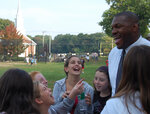Valley Stream South High School has a new chief ahead of school year
Matthew Swinson has been named principal of Valley Stream South High School for the upcoming school year, succeeding Maureen Henry who announced her retirement after a 16-year run.
Never as a young man did Swinson foresee a career path for himself in education. He said his commitment to education began as a “blissful accident.” Pursuing a bachelor’s degree in business management from the University of Maine, he had initially set out to make a name for himself in the financial sector. But during a visit to his alma mater at Bay Shore High School during his college break, Swinson said his former high school teachers told him they knew he had the makings of a great educator.
“When I told them my college major, my teachers said, ‘That’s wonderful, but have you considered impacting the lives of kids?’” Swinson recalled.
He was open to the idea, his foray into education coming in the form of substitute teaching for his hometown high school, which he sporadically took on throughout his extended breaks from college. After graduation and two “unfulfilling” years in the world of sales, he decided to pivot his career ambition to the classroom.
He first taught English Language Arts, social studies and science at Bay Shore Middle School, and later served in school administration as an assistant principal in Eastern Suffolk BOCES as well as in the Amityville and Port Washington public school districts. He earned his master’s in elementary education from Adelphi University and a certificate of advanced study in education administration from Stony Brook University.
In his most recent role prior to joining South, he was principal at Roosevelt High School, where he learned how curriculum development, community and family engagement, and teacher instruction and training all fit together and work synergistically with one another.
Now with two decades of educational experience, Swinson’s goal in his first year at South is to set a tone of compassion, high academic expectations, and a sense of community among students and staff.
Swinson said the key to creating a healthy school environment is reinforcing the right “structures and boundaries” for each student, which broadly defined means “the best practices that keep kids safe and set them up for a productive and meaningful future.”
Take a student who would prefer to go to trade school as opposed to the traditional four-year college route, noted Swinson. He said staff would reach out to local unions, for example, to help carve out a structured pathway for that student to secure opportunities for a career in a trade that provides him or her with a respectable wage and a quality standard of life.
Swinson also noted the importance of students’ feelings of safety and support reflected in the way they are disciplined when they are bound to “act out.” To that end, he said he is a firm believer in the use of restorative justice practices – a disciplining philosophy that accounts for the motivations and feelings of all concerned stakeholders and seeks to restore hurt relationships rather than simply dole out punishment to the offender.
“Having worked as an assistant principal in Eastern Suffolk BOCES, I learned how to get out in front of student behaviors,” Swinson said. “I learned how to understand the origin of student behavior and the reason why they may act out and make poor choices for themselves.
“And I learned how to interrupt that, to anticipate that, and pass that on to my teachers so that they can be prepared to respond to them in a way that’s supportive, forgiving, and corrective.”
He noted that the chaos and stress of the educational landscape over these past years demonstrated that the “work we do as educators is not easy. It’s not for the faint of heart.”
“We need to build a sense of community first,” he added, “and that boils down to, you know, students being seen, heard and celebrated, and teachers deserving to be seen, heard and celebrated.”

 80.0°,
Partly Cloudy
80.0°,
Partly Cloudy 







